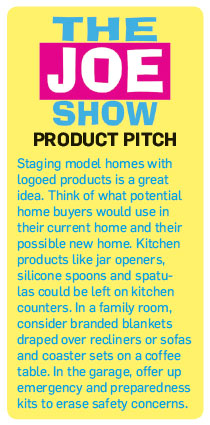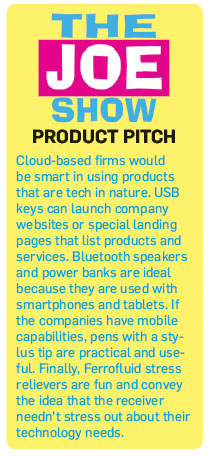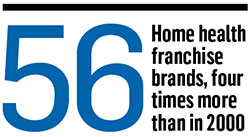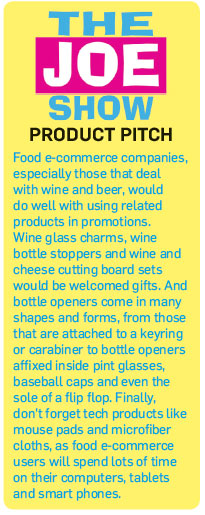Awards May 01, 2016
Four Hot New Markets
Four hot sectors provide ample sales opportunities for distributors.

Residential Construction
Residential construction has been climbing since 2012, after the burst housing bubble caused a five-year downward spiral. Census data shows that monthly spending on home construction dropped to $91 billion in May 2009, but by July 2014 had bounced back to $187 billion. Residential building construction grew 12.8% just last year, becoming one of the 10 fastest-growing industries in small business. Contractors involved in site preparation, utility lines and mechanical equipment installation have all been growing sales since 2012. Jay Dwivedi, business consultant and president of Xinvest Consultants, expects that steady growth will continue at around 11% over the next two years.
“There is a large number of millennials entering the housing market and interest rates are low in a lot of areas of the country,” says Elizabeth Jenkins, marketing specialist at real estate lender Source Capital Funding. “With the crash of 2008 in the rearview mirror, people are feeling confident again in the idea of buying a home.”
“These smaller businesses, local in scope, face lots of competition. It’s exactly the type of business that needs promotional products.” --Marc Landis, Phillips Nizer LLP
Although the industry is experiencing an upswing, the size of the development companies remains small, with most still being family-owned, says Marc Landis, managing partner of Phillips Nizer LLP and chair of the firm’s real estate practice. “These smaller businesses, local in scope, face lots of competition,” says Landis. “It’s exactly the type of business that needs promotional products.”
 Keith Jajko, marketing manager for Closet Factory, recommends model homes as a great place to use promotional products. “New home models, or sales offices, attract a lot of foot traffic and guarantee a steady stream of eyes to see the promotional products,” Jajko says. “Secondly, people visiting are generally in a pretty good mood – they finally have the funds to get into a new home and look forward to moving in. People with a positive frame of mind can be more apt to have a positive impression by the products they see.”
Keith Jajko, marketing manager for Closet Factory, recommends model homes as a great place to use promotional products. “New home models, or sales offices, attract a lot of foot traffic and guarantee a steady stream of eyes to see the promotional products,” Jajko says. “Secondly, people visiting are generally in a pretty good mood – they finally have the funds to get into a new home and look forward to moving in. People with a positive frame of mind can be more apt to have a positive impression by the products they see.”
NMS Properties, Inc., a Los Angeles-based real estate management firm, uses branded promotional products such as cups and keychains to “elicit a feeling of belonging.” Says Terra Andersen, director of Internet marketing for NMS Properties: “The goal is to create an all-encompassing living experience for our residents.”
Cloud-Based Technology
 Cloud-based technology has changed the Internet; dominant players like Google, Apple and Amazon offer a robust suite of services and apps that connect users and offer digital storage. Zach Hanlon, director of product marketing at Oracle, says cloud-based technology has all the benefits of an application or infrastructure or platform without any of the management responsibilities. Data is stored on a remote server and can be accessed from a website, which for business owners is cheaper than dealing with the costs of installing the hardware, updating it and performing security fixes.
Cloud-based technology has changed the Internet; dominant players like Google, Apple and Amazon offer a robust suite of services and apps that connect users and offer digital storage. Zach Hanlon, director of product marketing at Oracle, says cloud-based technology has all the benefits of an application or infrastructure or platform without any of the management responsibilities. Data is stored on a remote server and can be accessed from a website, which for business owners is cheaper than dealing with the costs of installing the hardware, updating it and performing security fixes.
“Companies should adopt cloud tech because it allows them to innovate and do better business,” Hanlon says. “On the flip side, you want to target those companies because those are the companies that are booming.”
The International Data Corporation (IDC) reported that investments in cloud companies are up 23% year-on-year, with $7.6 billion worth of revenues being reported by manufacturers of equipment such as servers, storage and switches. Two-thirds of small businesses are making the switch to cloud services, says Suzie Blaszkiewicz, cloud-based software analyst and editor at GetApp, a review site of online business software. “Being able to streamline business processes, along with more accessibility and affordability, is a huge benefit of the cloud for small businesses,” Blaszkiewicz says. “These companies wouldn’t normally be able to afford on-premise solutions. The fact that cloud-based software is becoming more available really gives them the tools that, up until about 10 years ago, were only available to the ‘big players’ who could afford expensive systems ranging in the hundreds of thousands of dollars.”
"It’s almost the start of a culture – we’re a startup, we need swag with our corporate logo." --Harry Ein, Perfection Promo
With the explosion of startups in not just Silicon Valley but around the United States, Harry Ein, owner of Perfection Promo (asi/232119), says his company has benefitted from two verticals: wearables and tech accessories. Those and other tech startups, he says, are often cut from the same casual cloth. “In this craze of more casual workwear, I’m seeing tons of people in American Apparel shirts,” Ein says. “It’s almost the start of a culture – we’re a startup, we need swag with our corporate logo.”
 For distributors looking to win over prospective clients, Ein says to be prepared with creative and unique products that will fascinate even the tech experts. “If you’re going in and trying to sell a calendar to a tech startup in San Fran, you’re going to embarrass yourself,” Ein says.
For distributors looking to win over prospective clients, Ein says to be prepared with creative and unique products that will fascinate even the tech experts. “If you’re going in and trying to sell a calendar to a tech startup in San Fran, you’re going to embarrass yourself,” Ein says.
Assisted Living
As the baby boomer generation enters its golden years, the assisted living industry is expected to skyrocket as more senior citizens opt for home health-care options and senior living facilities. The National Association for Home Care and Hospice says that 12 million people each year need some form of home health service. With the advancements in medicine and heightened focus on healthy living over the past several decades, the United Nations estimates that number will grow, as the amount of people over age 60 is set to triple to 2 billion by 2050.
 You don’t have to wait 30 years to cash in – investment bank Harris Williams & Co. says home health is a $30 billion industry. While there were just 13 home health franchise brands in 2000, the number jumped to 56 in 2014, research firm FRANdata reports. And those 56 franchise brands now operate more than 6,000 locations throughout the United States.
You don’t have to wait 30 years to cash in – investment bank Harris Williams & Co. says home health is a $30 billion industry. While there were just 13 home health franchise brands in 2000, the number jumped to 56 in 2014, research firm FRANdata reports. And those 56 franchise brands now operate more than 6,000 locations throughout the United States.
Brandi Kurtyka, co-founder of MyCNAJobs.com (which caters to certified nurse’s assistants and caregivers), says a distributor would “clean house” in the market. “Instead of going online to find promotional products companies, people would love to go to trade shows and have a real person to talk to,” says Kurtyka, whose company has offered branded scrubs and swag bags for caregivers.
Nina Shatz, brand development director at Top 40 distributor Halo Branded Solutions (asi/356000), says that in addition to the home health-care sector, senior living facilities are ripe for promotional products. “It’s not a one-shot deal with these places,” Shatz says. “They’re always re-ordering due to new residents and annual events.”
"It’s not a one-shot deal with these places. They’re always re-ordering due to new residents and annual events." --Nina Shatz, HALO Branded Solutions
The National Investment Center for Seniors Housing & Care reported that occupancy at senior living facilities rose to 91.3% in the beginning of 2015, continuing an upward trend. There were more than 11,000 units of facilities under construction at the end of 2014, doubling the historical average each quarter between 2008 and 2011.
With so many facilities pitted against each other, Shatz compares it to choosing which college to attend. “These people want to feel that they’re sending their loved ones to the best place possible,” Shatz says. “So we try to make them feel as welcome and comfortable as possible.”
 Shatz says putting the phone number and website address of the facility on the promotional product is crucial. Notebooks or white boards to write down appointment times or medicine schedules also help. “You want to provide a wow factor when they move in,” Shatz says. “You’ll have a basket waiting for them, maybe a pouch to hang from walkers, some towels or robes for more expensive facilities with spas.”
Shatz says putting the phone number and website address of the facility on the promotional product is crucial. Notebooks or white boards to write down appointment times or medicine schedules also help. “You want to provide a wow factor when they move in,” Shatz says. “You’ll have a basket waiting for them, maybe a pouch to hang from walkers, some towels or robes for more expensive facilities with spas.”
In terms of the staff, Shatz says most of the facilities are owned by hotels who want to create camaraderie amongst employees. Branded uniforms to differentiate the dining staff from the nurses or a line of polos for “associate of the month” are common requests that she receives.
Food E-Commerce
 Food may be a late addition to the e-commerce industry, but it could end up being its biggest player. Food and beverage remains the largest category in retail, with more than $600 billion a year in sales. While those sales used to exclusively come directly from in-store transactions, that won’t be the case much longer. Through 2018, online grocery sales will grow at a compound annual growth rate of 21.1%, reaching nearly $18 billion, reports BI Intelligence. Conversely, offline grocery sales will rise by 3.1% annually during the same period. And while online sales currently make up 3% of total grocery sales, e-commerce consultant Brick Meets Click predicts that number to jump to 17% by 2024.
Food may be a late addition to the e-commerce industry, but it could end up being its biggest player. Food and beverage remains the largest category in retail, with more than $600 billion a year in sales. While those sales used to exclusively come directly from in-store transactions, that won’t be the case much longer. Through 2018, online grocery sales will grow at a compound annual growth rate of 21.1%, reaching nearly $18 billion, reports BI Intelligence. Conversely, offline grocery sales will rise by 3.1% annually during the same period. And while online sales currently make up 3% of total grocery sales, e-commerce consultant Brick Meets Click predicts that number to jump to 17% by 2024.
Food tech companies (like food delivery and online ordering apps) have been growing quickly as well, with over 300 startups currently and $5.7 billion worth of funding last year (up 152% from the previous year), according to CB Insights.
“We’re always thinking about giveaways that make sense.” --Danita M.H., Rated M Wine Infused Foods
The market appeals to customers who want convenience and a variety of options and to business owners who can rely on a cost-effective model that offers massive exposure for new brands. Josh Frey, founder of On Sale Promos, has transitioned his company into the digital age by offering an e-commerce website that lures first-time buyers into long-term relationships. Frey calls it a hybrid model. “They start online, we then take them offline, and then we put them back online,” Frey says. Customers go to the site to order a product, giving their contact information to have the product shipped. That information gets tracked through an internal system so a sales rep can reach out via email to let the customer know when to expect the order. After it arrives, the rep gets feedback and follows up a few days later by asking for a referral in exchange for the customer receiving a gift.
 Danita M.H. of Rated M Wine Infused Foods has used this hybrid model to considerable success. She and her team go to farmers markets and food festivals throughout Florida to offer people samples of her raspberry- and peach-infused wines, cocktail salts and sorbet. After taste testing, she hands out business cards and other promo products with the company’s website so people can order from RatedMMM.com.
Danita M.H. of Rated M Wine Infused Foods has used this hybrid model to considerable success. She and her team go to farmers markets and food festivals throughout Florida to offer people samples of her raspberry- and peach-infused wines, cocktail salts and sorbet. After taste testing, she hands out business cards and other promo products with the company’s website so people can order from RatedMMM.com.
Rather than opening a storefront, Danita prefers to rely on e-commerce channels such as Amazon and her website. “We have the whole world at our feet, and people from everywhere can look at our products,” Danita says. “We’re in some local stores, but it’s tough because once you go through all the work of getting on the shelf, now comes all the work of getting off the shelf.”
Danita says she constantly develops brand awareness through consumer engagement, meeting people at events and partnering with local nonprofits to send out gift bags, physically putting the product into the consumer’s hands. “We’re always thinking about giveaways that make sense,” Danita says, mentioning logoed sunglasses for lounging on the beach with a margarita and logoed stress balls for chefs under pressure in the kitchen.
Email: jcorrigan@asicentral.com; Twitter: @Notready4Radio
